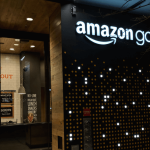Michigan’s manufacturing past is fueling its tech future
Michigan’s struggles have played out on the world’s stage. Just after the turn of the century began what’s referred to as the state’s lost decade, the economy faltered, oil prices skyrocketed and the housing market crashed. Nearly a million jobs left the state between 2000 and 2013, many of them in manufacturing and the automotive industry. For a state of just under 10 million people, the impact was devastating: Unemployment was higher than the national average by more than four percent.
Bailouts for Chrysler and General Motors were followed by Detroit’s record-setting municipal bankruptcy, but through grit and determination, Michigan started clawing its way back from the brink. Now multimillion-dollar investments in the city from tech titans like Amazon, Facebook and LG make headlines with startling frequency, and a host of tech startups have begun to fill the gaps left by plant closures.

Motown was a different place when Damien Rocchi relocated from Australia eight years ago. Among regions with more than a million residents, Detroit’s unemployment rate ranked highest in the nation, with 16.7 percent of people in the metro area jobless. The city hadn’t replaced streetlights rendered useless by copper thieves during the Great Recession either, so many of Detroit’s pockmarked avenues and seven-lane roads were pitch black come nightfall. That September, the FBI reported Michigan’s violent crime rate was 10 percent above the national average. Things were desperate.
During Michigan’s lost decade, Quicken Loans’ billionaire founder Dan Gilbert took advantage of Detroit’s empty builds and low land costs. He began buying property in and courting talent to downtown Detroit before moving Quicken Loans’ headquarters and 1,700 employees from nearby Livonia to downtown in 2010.
Gilbert-related companies now control 90 buildings downtown, and the mogul has thrown over $2 billion at real estate and tech ventures. These include the M-1 Rail streetcar system (“Gilbert’s little choo-choo,” one source joked), which weaves through the burgeoning business district; an online stock market for sneakers; a symmetrical fiber-optic internet service that’s half the price of Comcast’s; and Rocchi’s Grand Circus. This February, Gilbert convinced Microsoft to leave the suburban location it had occupied for 30 years for his One Campus Martius building. People have begun referring to the sections of downtown he’s rebuilding in his own image as Gilbertville.
Along with the late Mike Ilitch, founder of Little Caesar’s and former owner of the Detroit Red Wings and Detroit Tigers, Gilbert has been one of the biggest driving forces in Detroit’s recovery. Not everyone is happy with his influence on Detroit though. “He just went further and harder than everyone else,” said a person from the tech community who wished to remain anonymous.
The source described a recent Detroit Demo Days hosted by Quicken Loans, with $1 million in capital up for grabs. If a company took first place from a field of 20 finalists, it would get a 48-month, $200,000 interest-free loan to move to downtown Detroit. The two teams that ended up winning were already located downtown: upscale barber shop The Social Club and vocational-education outfit the Detroit Training Center. “They’re essentially vendors that would raise Gilbert’s property value,” the source said.
“It’s kind of a spur for Detroit people to actually put their money to work in Detroit.”
That’s not to say Gilbert isn’t doing good in Motown. Sources said that Gilbert’s monopoly on downtown real estate is having a ripple effect that’s beneficial to the city. “It’s kind of a spur for Detroit people to actually put their money to work in Detroit instead of sitting in a hedge fund somewhere,” the source said. While Gilbert may be acting in self-interest, his interests often align with those of the city.
He’s a firm believer in technology’s ability to help Motown rise from the ashes. One example of this is the Cheese Factory, a Quicken Loans skunkworks program where employees pitch everything from new salad dressing for the cafeteria to wiring Detroit for ultra-high-speed broadband.
Rocket Fiber is a fiber-optic internet service that offers gigabit speeds. It’s “a story of not waiting for it to happen, not waiting for someone else to come here and hope they build it,” according to founder and CEO Marc Hudson. “It’s really a story of a Detroit, Michigan-based organization doing it on their own.”
Hudson pitched the idea via the Cheese Factory in Jan. 2013 after reading how Google Fiber was attracting tech companies to Kansas City. After graduating from Michigan State University, he worked on his own web development startup and fell in love with downtown Detroit before working at Quicken Loans as a user interface engineer.
After the initial pitch Hudson got in contact with Gilbert directly, formed a team and began working on Rocket Fiber on nights and weekends before getting enough internal support to make it his full-time job. After a “long, two-hour meeting,” pitching the financial model and viability to Gilbert and his quasi Shark Tank, he got the green light.
The 1Gb service launched in May 2014 for $70 per month, with no service agreements or equipment-rental fees. Ten Gb service is $299 per month. The idea is that in its admittedly smaller service area, customers will be happy enough with their connection that they don’t need a contract to stick around. Comcast charges $139.95 per month without a contract or $70 per month with a three-year service agreement for speeds of up to 1Gbps.
Hudson wouldn’t go into specifics about subscriber numbers, but as of July he said that there were “several thousands” across 200 commercial and residential buildings downtown. Rocket Fiber is dubbed Detroit’s technology partner on billboards around the city. It’s providing internet service to the QLine streetcars and WiFi for the 65,000-capacity Ford Field, and it installed 10Gb service at the revamped Cobo Center convention hall. The latter is a bid to draw esports events and virtual reality exhibitions to the convention center, according to Crain’s Detroit Business.
“We want to fundamentally change this industry and make it more scalable and more automated so that companies like Rocket Fiber can compete with the larger entrenched companies,” Hudson said.
“It’s cool to say we’re not some company from out of state, from another city.”
He said that the idea was to be a “moonshot for Detroit” and that there was never an idea of going to another city. For him and his team, comprised of CTO Randy Foster and COO Edi Demaj, there wasn’t any interest in doing this anywhere outside the D. “It was always about taking care of our hometown and doing something really cool and fun here,” he said. “It’s cool to say we’re not some company from out of state, from another city. We’re a Detroit-headquartered company creating jobs in the city, employing Detroiters and building an internet infrastructure that exists in few other places.”
All of Rocket Fiber’s team members live in the metro area, and a “good number” of the company’s contractors do as well. Hudson has even managed to get local senior-level talent who had moved to Silicon Valley to come back home. Outside network engineers, designers and biz-dev folks poached from competitors, most of Hudson’s employees don’t have a background in telecommunications and are trained on the job.
Hudson described a new hire who’d never touched an Ethernet cable in his life but had a great attitude and was a good fit for Rocket Fiber’s culture. “Put me to work and I’ll learn,” the new hire told Hudson. He had started as an apprentice, shadowing experienced residential installers during his first week on the job. “They’ve been teaching him, and he’s just been soaking it up like a sponge,” Hudson said. Now he’s doing service installations.
For Hudson, it’s about creating opportunity, something the Motor City hasn’t always done. That doesn’t mean Rocket Fiber will open its doors and invite thousands of the city’s displaced automotive workers to start installing internet service; the company isn’t ready for that yet. But it can help on a smaller scale. “[We’re] trying to play a small part in creating opportunity here, because when opportunity is not equal, it leads to issues that I think Detroit is a pretty good case study of,” he said.
Jacques Panis, president of luxury watchmaker Shinola, agreed. For someone with no prior skills, it takes between two and four weeks to go from the first application to being an entry-level Shinola employee. One employee was a security guard in a past life. Now he’s leading the company’s movement-assembly team.
“The walks of life here are something that are absolutely incredible and really speak to what we have and why we have it,” he said. “It’s not just about you coming in here and having a specific skill set. It’s about you coming in here and having the ability to work with people and be a part of a team at a bigger picture and aligning with everyone here.”
Out west, the tech and startup scene is a little different. While Henry Ford was dreaming up assembly lines and the Model T, Grand Rapids, a quarter the size of Detroit, was a hub for the logging and furniture industries. The latter still holds sway in town; Herman Miller, Steelcase and Haworth all have headquarters there. The metro area also has a rapidly expanding medical-research scene, a number of well-regarded craft breweries and Amway’s global headquarters. Rather than assembly-line jobs, many of the automotive plants in town focused on stamping or tool-and-die making, like the 1,500-employee stamping plant that made sheet metal parts for GM trucks and SUVs that was shuttered in 2009 or Riviera Tool, which was acquired by Tesla in 2015.
Unlike Detroit, the city is incredibly conservative, both socially and fiscally. The former comes from a predominant Catholic and Christian Reformed culture, with a combined quarter of residents identifying as either denomination in 2010. There’s a distinct irony in tourism boards calling the nearby Lake Michigan shoreline “Michigan’s West Coast” when the region is anything but liberal. In Detroit, Weedmaps billboards dot the highways; in Grand Rapids, it’s hospital advertisements with a photo of a Dutch wooden shoe on a prosthesis under “Keep on klompin!” Alcohol sales are restricted before noon on Sundays, when plenty of local businesses are closed all day. Finding anything to do after 10 PM that isn’t sitting at a bar is close to impossible. As in many Rust Belt towns, mom-and-pop shops reign supreme.
When Detroit fell, Grand Rapids merely stumbled. In 2009, unemployment hovered near 10 percent, a little over half of Detroit’s jobless rate. Even with its fiscal conservatism and diversity of businesses, though, numerous businesses downsized and closed, just not at the rate they did on the east side of the state.
This January, unemployment in Grand Rapids dropped to 3.1 percent.
Grand Rapids’ battles following the economic downturn were different than Detroit’s, Tim Mroz, vice president at The Right Place, said. “Our biggest challenge in 2012, 2013 and 2014 was that there was so damn much cash in the bank for these manufacturers that it was just sitting, waiting for something to do with it.”
That’s where Start Garden, the incubator founded by Amway heir and Secretary of Education Betsy DeVos’ son Rick DeVos, comes in. The accelerator works to match tech startups with established local businesses like Steelcase as a way of marrying tech ideas with manufacturing. From its outset in 2012 until 2015, Start Garden offered $5,000 per week for a good startup pitch. On monthly Update Nights, previous winners would compete for an additional $20,000 in funding. One of its biggest early successes? Boxed Water Is Better, the purified tap water that comes in minimalistic paper cartons.
“That [funding system] was almost like us teaching ourselves what would really work here,” Start Garden Director Paul Moore said. Now Start Garden’s business model has changed.
“What started to become really clear was that we had these large enterprises that really needed to make a bridge into the startup community, [and] startups that wanted to bridge to them,” Moore said. “A small startup isn’t going to build up the capacity to build 30,000 pieces of furniture and ship them around North America from a facility every month, and that company that’s 100 years old isn’t going to just suddenly turn itself into a tech company overnight.”
Local investors don’t see the value in something that isn’t tied to manufacturing in some way. “If a young person were pulling together a Snapchat-like app, I don’t think this is the place for that,” Moore said. Michigan is known for making things and, for better or for worse, probably always will be. Local firms aren’t excited about an app for sending photos; they want something that’s tangible and plays to their logistic and production strengths.
“The whole concept of a unicorn is pretty lost on our culture.”
“We find that, oddly enough, that’s a really hard sell in a place like the Valley,” Moore said. That’s because the cultures are different. When someone in San Francisco dreams up a piece of hardware, the first thing that comes to mind are the year-plus shipping and production bottlenecks of dealing with China or Korea. Hence a focus on software. Michigan is the exact opposite. “The whole concept of a unicorn is pretty lost on our culture,” Moore said, laughing. “[Grand Rapids startups] aren’t like ‘ship it in three months to the cloud and you’re up and running’ kind of things.”
Here, industrial designers and engineers are familiar with the timeline and process of getting a manufactured good to market. Rent is going up, but compared to San Francisco, Boston or even nearby Chicago, it’s cheap enough that waiting a year or more for your product to come to market might not drain the bank account.
Not everything tech-related in Grand Rapids involves Start Garden, and not everything in Detroit involves Dan Gilbert. The Right Place, a West Michigan business accelerator, recently lured data center company Switch to set up its $5 billion Eastern US data center in the confines of a nearly 660,000-square-foot, cement-and-glass pyramid. The quirky space served as Steelcase’s research-and-design headquarters for over two decades until the Great Recession forced the office-furniture manufacturer to sell it in 2010. The first-phase rollout began earlier this year, and the center is expected to employ up to 1,000 people within the next 10 years. The location currently handles data for Activision, Amazon, eBay, Google, Sony and others.
“Simply by making that decision [to locate in Grand Rapids], it raised the tech landscape several levels that would have taken a decade or two to build on our own,” Mroz said. “We got a free ‘skip ahead 20 years’ card.” The possible ripple effect of Switch’s investment can’t be understated. There will be at least 150 full-time jobs there, and over 700 Michigan construction workers will be retrofitting the building over the next five years. “Almost 99 percent” of the workers on-site are Michiganders, a Switch representative said.
Everyone needs to eat and get to work, too, so restaurants and gas stations are bound to pop up as well. So far, Mroz said that a hotel has already been planned for the area. That’s in addition to the tech jobs that may be created from Switch’s mere presence. “If you’re a growing IT company and you’re going into data-managed services, what better thing to put in your marketing materials than to say, ‘We’re co-located X amount of miles from Switch’s East Coast data center?'” Mroz asked.
“Hopefully it’s a real attraction for tech companies and industry players to say they want to have their equipment there,” Michigan Governor Rick Snyder said.
This week Switch raised over $530 million for its IPO.
Next to its workforce and culture of innovation, comparatively inexpensive housing and cost of living are one of Michigan’s strongest selling points. Almost everyone interviewed for this piece said the same thing: The state isn’t doing enough to market itself. The Pure Michigan TV spots with Tim Allen voice-overs work to promote tourism outside the state, but there aren’t a lot of efforts being made to attract talent from the coasts for permanent residence. Once people get to Michigan and see what the state has to offer in terms of quality of life, their minds start to change. It’s getting them to consider Michigan that’s the hard part.
“The best way you can get somebody here is to have warm referrals,” Governor Snyder said. “People that have had experience here.” Shinola’s Panis agreed and has seen that in action himself. He described a New York couple who visited him over the Fourth of July weekend. The man holds a degree from Harvard, the woman a degree from Brown. “There are people that are highly successful, highly educated, highly in tune with the environment around them, and this is where they want to be,” he said.
People mistakenly think the state is under multiple feet of snow for half the year. Cindy Brown from Hello West Michigan, a nonprofit that works to educate and attract talent to the area, said that the biggest misconception she hears is that there’s nothing to do during the Mitten State’s infamous winters. “Every state has an indoor season,” Brown countered. “You’ll hear people in Arizona say that you can’t go outside until late at night because it’s so hot during the day; we are no different.”
“Get over it. Go build a snowman.”
“Make a fire in the house on the weekend rather than going out to the lake,” Panis said. “Get over it. Go build a snowman.” He relocated to Detroit from Texas in 2012 and said there’s nothing he can think of that’d make him want to leave Michigan.
Hello West Michigan started in 2010, but because of its nonprofit status, its reach is bound to a limited marketing budget. Brown stressed that Hello isn’t an employment agency; rather, it connects candidates with employers, specifically targeting spouses who may be moving with someone poached from the coasts. The companies it works with and receives funding from are the biggest employers in the 13-county region, but even then, money only goes so far and Brown has to be careful where she spends it. Billboards didn’t offer much of a return five years ago, so those stopped. Now the organization advertises at Grand Rapids’ Gerald R. Ford International Airport and on Facebook and LinkedIn.
The former hits people when they’re arriving and leaving while the latter offer inexpensive ways for her company to target the specific job seekers that local employers are looking for. Currently Brown is targeting IT professionals who’ve left for jobs in California to get them to rethink the area. If you’re considering coming back home, Brown said it’s her job to make sure you know you’re welcome and aware of how West Michigan has changed since you’ve left. “There’s nothing wrong with leaving, just as long as people know there’s an open door,” she said. “Try new things, but always know you can come back.”
This summer was one of the busiest Brown has seen in her six years with the company.
Grand Rapids and Detroit are the two biggest metropolitan areas in the state, so people naturally gravitate toward them. Tech can’t save small manufacturing towns that were devastated when industry left for cheaper climes like Mexico or China. Saginaw spent nine years as the most violent city per capita and has been wracked with hardships following closures of GM-related shops during the Great Recession. In July 2009, the 18-square-mile city’s unemployment topped that of Detroit’s, with nearly a quarter of the workforce out of a job. Unemployment has since dropped to 5.3 percent, but its population also fell by around 6,000.
And then there’s Flint, which needs no introduction. The city is still reeling from a lead-poisoned water supply, and unfiltered tap water won’t be safe to drink for more than two years. Lead levels recently dropped below the federal action level of 15 parts per billion, but there are still 20,000 lead and galvanized pipes carrying water in the city. Until those are replaced, filters will be a way of life. Or can tech fix that? Flint has pitched itself as one of the cities where Amazon could locate its second headquarters, and that $5 billion investment would go to a city that couldn’t need it more.
But the competition is fierce. Gilbert is putting together a pitch for Detroit, and his prowess at landing huge deals could be more attractive than what Flint could offer. Would Amazon set up shop in a city where its employees couldn’t drink or bathe in tap water?

Michigan is in the process of rebuilding itself. Again. Chrysler paid off its government debt in 2011, with GM following suit in 2014. That same year, Detroit exited bankruptcy in record time. Motown flipped the switch on 65,000 new streetlights last December. As of this April, statewide unemployment dropped to 4.7 percent. On paper, everything sounds like it’s on the upswing.
The low unemployment numbers don’t tell the whole story, however. Unemployment stats only count those who are out of work and either seeking a job or are enrolled in training or education. If you aren’t looking or have a part-time job (or multiple part-time jobs), you aren’t counted as being jobless. Another factor is the workforce’s inability to pass drug tests and the growing opioid epidemic. Last year Michigan doctors wrote more opioid prescriptions than there were men, women and children in the state.
Where does the state go from here? Grand Circus’ programs continue to expand, but Rocchi said that classes are the size they are because it’s how the company keeps from flooding the market. If more people are graduating than can find jobs, his programs lose their appeal and the sizable investment from students becomes harder to justify. But Michigan will need more than his boot camps and Start Garden’s tech partnerships.
Around 14 percent of new jobs in the state come from the auto industry, but Start Garden’s Ross II argues that the likes of Ford, Chrysler and GM are transitioning from purely automotive companies to mobility companies. You can see this at the sprawling 500-acre driveline-assembly plant at Willow Run in Ypsilanti, which began life cranking out B-24 bombers during World War II under Ford’s control and is now being transformed into an autonomous-vehicle-testing complex for the likes of AT&T, Ford and Toyota. The facility broke ground late last year, and autonomous testing will start in December.
The missing piece is people.
This new, tech-driven manufacturing also involves vendors outside the usual suspects, like LG for lithium-ion batteries made along the Lake Michigan shoreline in Holland or the planned $25 million EV-parts plant that will employ almost 300 in Detroit suburb Hazel Park.
The missing piece is people. People to help fill Detroit’s seven-lane city streets. People who will take the forward-looking manufacturing jobs being created. People willing to move from Austin to pursue their game-development dreams. People who start companies to fight Comcast head on for customers. People who will set up shop and train locals in new crafts. People working night and day to attract new talent to the state. People turning Michigan into a 21st-century manufacturing powerhouse. The kind of people who pulled the state through its lost decade.
“When things get hard, you reinvent yourself,” Start Garden’s Ross II said. “If I was a betting guy, I would bet on Michigan anytime.”
On the state’s west side lies Grand Rapids, where 20 percent of the area’s residents are employed in manufacturing jobs, twice the national average, according to a recent report from the Los Angeles Times. The median wage for such workers? About $30,000 per year — enough for a single person but hardly enough to raise a family. A recent wage survey found machinists in the region averaged $41,710 per year, around half that of software and application developers.
Manufacturing is changing, and assembly line jobs are increasingly being handled by robots. Where humans were once doing the physical labor themselves, they’re now supervising several machines at a time or operating as quality control. As time goes on, more areas of low-skill labor will be taken over by artificial intelligence, machine learning and automation in what’s being labeled the fourth industrial revolution.
“When you walk through a plant, there are going to be very few humans on the floor, but there’s going to be hundreds of people that are high-tech [trained], maintaining all those systems, because they’re not stupid systems that are just stamping out metal parts,” said Tom Kelly, executive director of the Michigan-based nonprofit Automation Alley. “Michigan is poised extremely well to play in that space, because we know how to make things. We know how to make things high quality, cheaply, quickly. All the things you want, and at volume.”
The bottleneck is talent.
(54)













